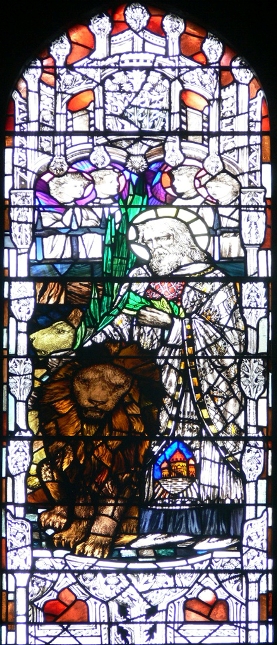Saint Ignatius of Antioch

Ignatius (ca. A.D. 35- ca. 107) is said to have been the second or third bishop of Antioch in Roman Syria, the third largest city in the Empire, located on the river Orontes, inland from the Mediterranean, now Antakya in Turkey. Ignatius was part of the second generation of Jesus’ followers, at a time when the structures of the Church were developing. We know about Ignatius from the seven letters he wrote while he was on his way to Rome to be martyred. There are also acts of his martyrdom. Ignatius is believed to have been martyred at Rome sometime before A.D. 117. Legend has it that he was turned over to the lions (hence our parish emblem), who ate him up, all except his heart.
Ignatius was particularly focused, as he faced his own death, upon imitating Jesus’ own suffering, writing, "if I suffer, I shall be emancipated by Jesus Christ; and united to him, I shall rise in freedom" (Ignatius, Romans 4:3). He saw himself as "God’s wheat ... being ground by the teeth of wild beasts to make a pure loaf for Christ" (Ignatius, Romans, 4:1).
He was also keenly concerned with the unity of the Church. He believed that the ministry of Bishops and regular communal celebration of the Eucharist were key to maintaining this unity. He urged, "Be careful, then, to observe a single Eucharist. For there is one flesh of our Lord Jesus Christ, and one cup of his blood that makes us one, and one altar, just as there is one bishop along with the presbytery and the deacons" (Philadelphians, 4).
A third major theme of his teaching was to refute the docetic heresy that taught that since matter was inherently evil, the Incarnation could not have been real. Ignatius was insistent in his belief in a Christ, "of David’s lineage, of Mary, who was really born, ate, and drank; and really persecuted under Pontius Pilate; was really crucified and died .... [and who] was really raised from the dead" (Trallians, 9). Ignatius believed that Jesus’ Incarnation gave special value to what we do in our lives. In his writings he exhorted Christians not just to believe in the Gospel, but to live out a Gospel life and was severely critical of whose who, "care nothing about love." Indeed, "those who profess to be Christ’s will be recognized by their actions" (Ignatius, Ephesians 14:2).
Ignatius also had a keen sense of perspective about the nature and form of that Gospel, living as he did in a world before the emergence of a Christian Bible. He wrote, "When I heard people saying, ‘if I don’t find it in the original documents, I don’t believe it in the Gospel,’ I answer them, ‘But it is written there.’ ... To my mind it is Jesus Christ who is the original documents. The inviolable archives are his cross and death and his resurrection and the faith that came by him" (Philadelphians, 8:2). For Ignatius the Church was the community, "unified in the bread" of the Eucharist (Ephesians 4:2) , that responded to the Gospel, not just to documents, by imitating Jesus’ life and death so they might share in his resurrection (see Ephesians 13:1).
Ignatius appeal to the Anglo-Catholic movement can certainly be seen in his own antiquity, his affirmation of the reality of the Incarnation, the importance of Christian unity and the ministry of Bishops, as well as the importance of the Eucharist.
In the Episcopal Church his feast day is celebrated annually on October 17, and in this parish we celebrate the Sunday closest to that date as our Patronal Feast.
Good modern editions of his writing are found in:
Cyril C. Richardson, Early Christian Fathers, Library of Christian Classics (New York: MacMillan, 1970), 74-120 (from which the quotations on this page are taken).
The Apostolic Fathers: I Clement, II Clement, Ignatius, Polycarp, Didache, ed. and trans. by Bart D. Ehrman, Loeb Classical Library (Cambridge, Mass.: Harvard, 2003), 203-321.
An excellent resume of his life is in The Oxford Dictionary of the Christian Church, ed. by F. L. Cross, 3rd ed. (Oxford: University Press, 1997), 817-818.
The Wikipedia article is not bad either and has some good links.
—Fr Blume
Read Fr Blume’s sermon about Saint Ignatius for the Patronal Feast:
October 19, 2008
October 21, 2007 (his first Sunday as Rector)
The image above to the right is the restored Saint Ignatius of Antioch window in the nave of the Church of the Advent, Boston, designed by Christopher Whall (1910).
